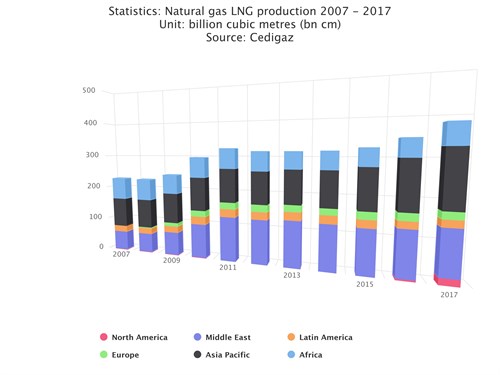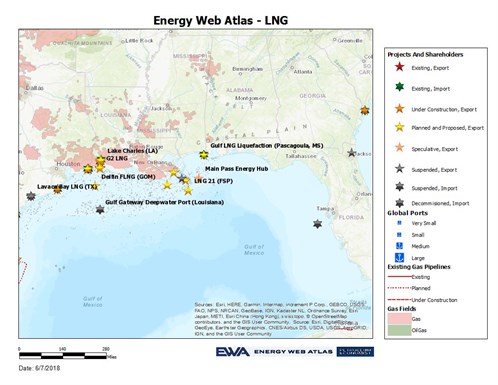Global LNG: Are we sailing towards more diversity?
In 2017, global LNG trade increased by nearly 10%, the strongest growth in a decade. Arguably, the LNG market is expanding both in size and complexity. But can we expect more diversity?
 |
| LNG Production 2007-2017 (Source: EWA) |
The time of the cozy LNG market has gone. Looking at the matrix constituted by the 19 exporting and 40 importing countries, we see a multiplication table of nearly 800 possibilities. Not only has the LNG market gone global, but it is multilateral and this new dimension is already bringing an intrinsic diversity to the business.
On the export side, the number of projects having recently started production or being about to do so represents up to 20 new LNG sites. Many of these American projects are mostly located in the Gulf of Mexico, making their contribution to global diversity limited in geographical terms. However, originality might be more visible on the commercial side. Indeed, business models can differ, from tolling-based structures to integrated ventures and given the intense competition between such close neighbours, marketing efforts are likely to lead to innovative deal structures and indexations.
 |
Australia is the other emerging exporting power. Here, many projects are adding up liquefaction capacity, although not necessarily creating new LNG routes. Most of the capacity is held by large corporations and sold to legacy Asian buyers, so diversity may not come from that side.
The main challenger to Australia and America for global production leadership is Qatar, where growth would be achieved through a mere copy-paste of existing facilities and schemes. However, these would not substantially displace the center of gravity of LNG exports.
The most disruptive seller to have recently joined the race is undoubtedly Yamal. Creating a new LNG pole on the far north of the globe, and with an innovative shipping model, this project is clearly fostering a re-shaping of market dynamics, both in the Atlantic basin where the need for transshipments in Europe stimulates the terminal operators, and in the Pacific Basin where the potential of the Northern Sea Route will displace volumes and tweak prices.
At the other end of the chain, only one country joined the LNG importers scene in 2017. Due to the Zohr field discovery, Egypt may disappear from the buyers’ map and for traders especially, this represents a cut in the spot market diversity.
At a slower, but larger scale, South America as a whole could fade away from sellers’ radars. Given Brazil’s vanishing spot LNG demand, mainly due to domestic gas production, and Argentina’s willingness to curb expensive LNG imports, the most attractive place in Latin America for LNG might well become Panama Canal.
Still, the number of buyers per importing country has been increasing. In countries like India or China there are healthy signs of diversification, even if the road towards efficient unbundling and third-party access is still long.
In terms of company profiles, diversity is a mixed picture. At the top of the pyramid, the concentration at big Oil & Gas companies is continuing. After Shell’s two takeovers of Repsol and BG, the recent acquisition of Engie’s LNG assets by Total is leading to a very concentrated landscape. However, smaller players are emerging, boosted by the current buyer-friendly cycle. We can observe a growing interest for LNG coming from industrials, regional traders and commodity retailers.
Then comes small scale and bunkering, which provides new technical drivers and new usages of LNG that are creating traction on the whole chain, as we get closer to the 2020 IMO emissions deadline and other local green policy incentives. Depending on the actual volumes involved, this could bring a whole new culture into the LNG industry.
Overall, we could argue that the current growth of LNG markets might not create as much diversity as expected – at least for now. But there are definitely new animals in the making, and in a couple years, the oceans could look very different.
If you would like to hear more on global gas and LNG developments, be sure to register to attend the 2018 Gastech Exhibition and Conference and gain exclusive market insights by market experts.
By: Jean-Christian Heintz, Director, Wideangle LNG

- ExxonMobil halts 1-Bft3d blue hydrogen project in Texas
- Aramco and Yokogawa commission multiple autonomous control AI agents at Fadhili gas plant
- Ukraine will resume gas imports via Transbalkan route in November
- Mitsubishi to inject $260 MM into Brunei LNG project
- Freeport LNG (U.S.) on track to take in more natgas on Thursday after unit outage



Comments